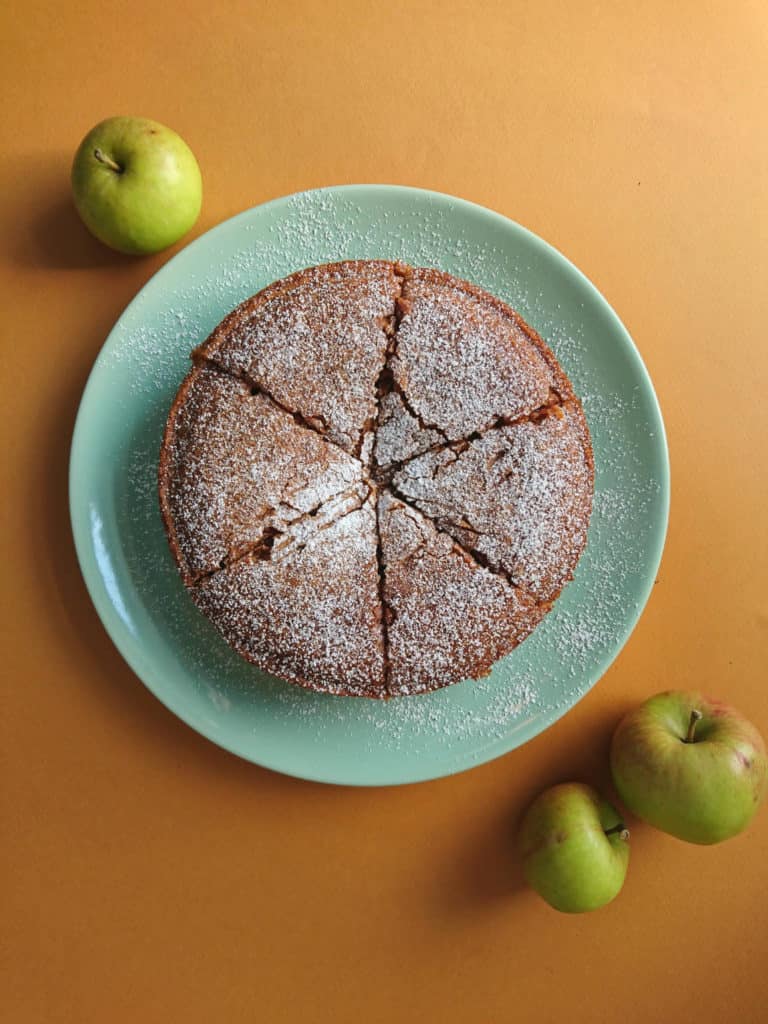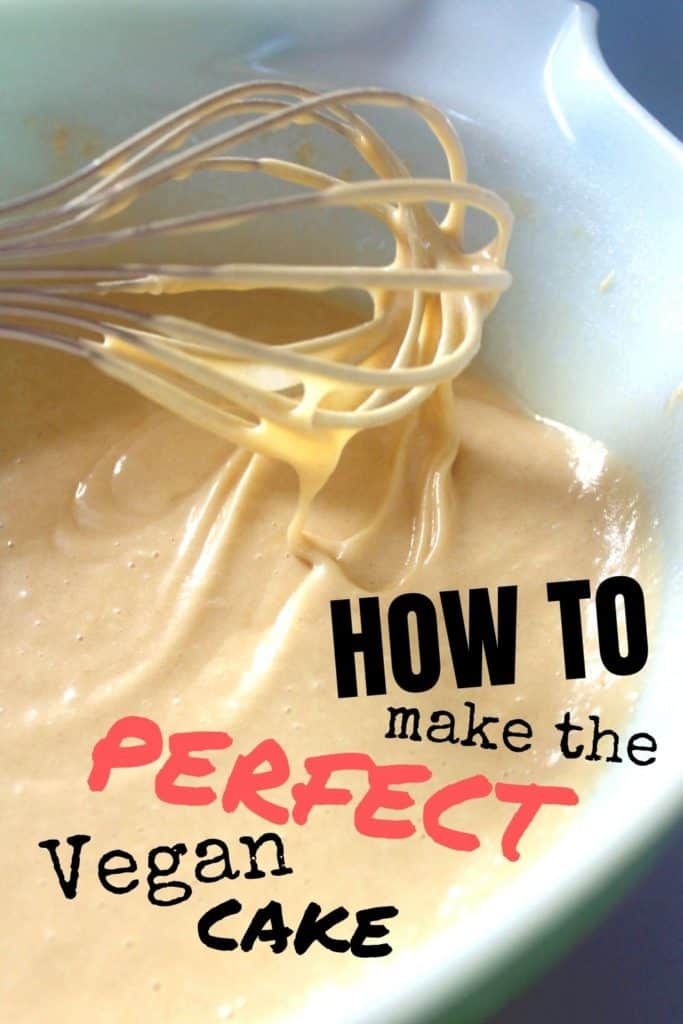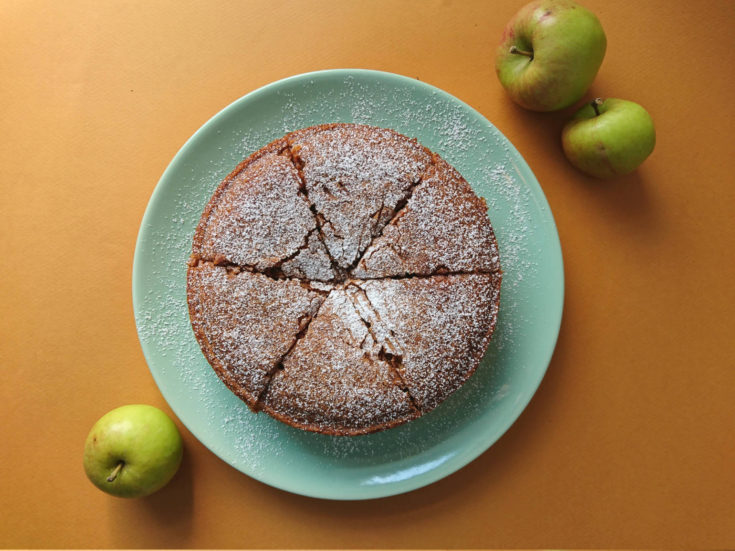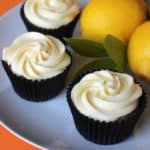
This vegan apple cake is based on a traditional Russian recipe. It’s easy to make but creates something surprisingly complex. Serve it warm and freshly baked from the oven and you’ll find out for yourself. The layers are perfect. First, your fork breaks through a crisp, golden top into a soft, lightly spiced sponge, then a layer of sweet, juicy apple. It’s an awesome combination of flavours and textures.
Surprisingly, all you have to do to create it is pour some cake batter over apple slices and bake it. There’s a reason why these classic recipes stand up to the test of time, so I’m excited to share my vegan apple sharlotka recipe. I plan to make more Russian vegan recipes in the future, but for now this cake makes a delicious alternative to an apple pie. Actually, a vegan apple pie should be my next project, so watch this space. I can always do with more ways to use apples while they’re in season.
Anyway, before I get caught up talking about apple recipes in general, back to this specific cake!
How to make a Russian vegan apple cake
Traditionally it’s a whipped egg sponge. It’s light, and the top browns well. The moisture from the apples steams it as it bakes, so the result is moist and light.
The key to its special texture and layering is using the right sponge.
But this recipe is egg-free of course. I’ve used a vegan cake ratio I’ve used many times and made adjustments to suit vegan sharlotka (check out a variant I used to make chocolate brownies here). Crucially to make a sharlotka, I’ve reduced the soy milk to make the batter thicker. This stops the apple layer floating up into the sponge during baking – so we get the layers and the steaming. Being thicker it also absorbs the additional moisture without getting too wet.
To enhance the flavour I’m using light brown sugar because it adds a whole additional layer of flavour over white sugar. Spices are also a key part of making an excellent Russian apple cake. Not too much, not too little, the goal is to balance them just right against the apple. I find one level teaspoon each of cinnamon and nutmeg is perfect.
After multiple tests, this has proved itself as a robust cake recipe. Sinking in the middle is the only risk I identified. Fortunately, you can avoid this by having all of your ingredients at room temperature and using warm soy milk.
I baked two identical cakes side-by-side in the same oven, one with cold apples and soy milk, and one with room temperature apples and warm soy milk. The benefit of using warm ingredients was clear as this was the cake that came out nicely risen.
This isn’t my first cake experiment with cold ingredients vs. room temperature. Cold ingredients increase the time it takes heat to reach the centre of the cake, and the result is the outside cooking much faster than the centre. Cold ingredients are a risk for all cakes, but most of all a sharlotka due to its apple layer. A half kilo of cold apple in the bottom will greatly slow down the heat penetration. The ideal situation is rapid heating throughout the cake during baking, so get the apples into a warm environment well in advance and warm the soy milk right before mixing it in.

Check out my guide to Baking Perfect Vegan Cakes
If you want to make the best cakes possible, this post is for you!
Why soak the apples in lemon juice and sugar?
The lemon juice and sugar soaking of the apples is not intended to flavour them – although it will impart a little. It’s a physical process needed for any apples used. The sugar draws out excess moisture from them, and the lemon juice stops them from browning. So don’t skip this step or move on before they’ve had the required 30 minutes.
Follow these steps and it’s easy to bake your own Russian vegan apple cake.
Russian Vegan Apple Cake (aka vegan apple sharlotka)

I love making this vegan apple cake in Autumn, it's warming and makes the house smell delicious. And the texture is perfect! First, your fork breaks through a crisp, golden top into a soft, spicy sponge, then a layer of sweet, juicy apple. Recipe from veganrecipebowl.com
Ingredients
apple layer
- 500 g cooking apples (peeled, cored and thinly sliced)
- 1 tablespoon lemon juice
- 2 level tablespoons soft brown sugar
to grease tin
- 1-2 teaspoons light olive oil
cake layer
- 150 g plain white flour (aka all purpose)
- 150 g soft brown sugar
- 3 level teaspoons baking powder
- 1 level teaspoon ground cinnamon
- 1 level teaspoon ground nutmeg
- 1/4 teaspoon salt
- 125 g unsweetened soy milk (warmed)
- 75 g light olive oil
- 3 tablespoons maple syrup
Instructions
- To prepare the apples mix together the two tablespoons sugar and one tablespoon lemon juice in a large bowl. Add the sliced apples, and using your hands rub the lemon juice and sugar all over them. Set aside for 30 minutes. During this time water will release from the apples.
- While the apples are standing, preheat the oven (190 °C, Fan 170 °C, 375 °F, Gas 5).
- Lightly grease a 20 cm (8 inch) cake tin with high sides. Don't use any baking paper – it gets wet and breaks down where the apple is touching it.
- When the apples are nearly done standing, start making the cake batter. In a large bowl mix together the dry ingredients (flour, sugar, baking powder, spices and salt) until evenly distributed and there are no lumps. Then mix in the liquids (soy milk, olive oil and maple syrup) until a smooth batter forms. Do not beat heavily or for any longer than needed to form a smooth batter.
- Remove apple slices from their bowl (discard the liquid extracted from them), and place them in an even layer across the bottom of the cake tin. Over this pour an even layer of the cake batter, then promptly place the cake in the centre of the preheated oven.
- Bake until the top is golden brown and a cocktail stick inserted in to the centre pulls out cleanly. This takes approximately 45-60 minutes – but ovens vary, so make sure to check it at about 40 minutes to avoid overcooking. When it is done, gently run a knife around the edge to separate it from the tin and allow to cool a little before serving.
Notes
Serving: Allow to cool for 5-10 miniutes before serving. Although delicious warm or cold – the crisp top and soft sponge are only present when served warm and fresh.
Storage: Cover and keep in a cool place for a up to two days.
Nutrition Information:
Yield:
6Serving Size:
1Amount Per Serving: Calories: 400Total Fat: 15gSaturated Fat: 2gTrans Fat: 0gUnsaturated Fat: 12gCholesterol: 0mgSodium: 344mgCarbohydrates: 67gFiber: 3gSugar: 43gProtein: 3g
Got any ideas or questions about the recipe? Join in the conversation below!




Ben,
This cake is my first attempt to bake a cake since I was at school and I’m no spring chicken. (and good to see chickens are safe here!)
My usual cooking method is:-
1. look at box
2. set oven
3. set timer
4. return at the alarm.
It’s just an automatic thing I do through not cooking whole foods, which you’re helping me do.
So, I did the same with this:-
1. I set the temporature and pre-heated to 180 (I think) – I already knew my oven needs to be lowered
2. set the timer
3. returned after 60 minutes when the alarm went off.
…and I have learnt now not to do this as my cake was slightly over cooked.
What I should have done was as you said “Bake until the top is golden brown” by watching the cake periodically.
It was still moist and nice, just some crispy bits.
Thanks
Lee (nervous cook)
Hi Lee, thank you for your feedback! Awesome to hear your cake was a success. You raise an important point too – all ovens vary and it’s best to check foods near the expected end time. I will be making this clearer in recipes from now on.
Feedback really helps me learn how to share recipes in the clearest way, so it’s much appreciated!
Cooked a little faster in my stove, but the shalotka was absolutely delicious. Used up the last of my maple syrup though and didn’t plan to buy more. Is it really important / is there anything else to use instead of maple syrup?
Darell
Hi Darell, excellent to hear you’re enjoying the recipe! The maple syrup is partly for flavour, but also acts as a humectant – an ingredient that helps the cake retain moisture. With this cake base I find it’s important for keeping a soft texture and avoiding the cake crumbling too much. You can replace it with a lighter flavour molasses or golden syrup with good results. Hope this helps 🙂
awesome recipe – would calculate more time for peeling and cutting all the apples though 😉
I also used applesauce as a substitute for (most of) the oil – worked great!!
thanks for this recipe!!
Hi SwissGirl, great to hear you’re enjoying the recipe! I will have to try your applesauce in place of oil adaptation soon, it sounds delicious 🙂
I am making this for someone with a soy allergy- can another milk such as almond or oat be substituted? thank you!
Hi Kate, I’ve used oat milk in this cake recipe with great results. Just replace soy milk with the same amount of oat milk and make the cake in the same way.
I’ve experimented with various non-dairy milks in a range of cake recipes (mine and other people’s), and I found they didn’t change in flavour, texture or volume. Baking times and browning didn’t change either. However, when there’s no allergy concerns I prefer soy milk for one reason – it makes the least fragile cakes. It’s because of the higher protein in soy milk, it bonds together with itself and proteins from the flour. It’s not a huge difference, but you will need to slice and handle the cake a little more carefully when using another type of milk.
Hope this helps, and enjoy your cake! 🙂
‘Best vegan cake’ was the feedback I received for this cake! Everyone loved it so I will definitely be making it again. I used Barrister oat milk as a substitute for soy milk and it turn out fine. I’ve finally found a vegan apple cake that taste good and is so easy to make! Thank you!
Hi Mumta, that’s so good to hear! I love this recipe too, there’s something about it that makes me keep baking it 🙂 Thank you for leaving feedback, it’s a big help
I have a lovely scalloped tin charlotte mold. I’m wondering if I can bake my apple sharlotka in it. If so, are there any adjustments in cooking temperature or time?
Hi Ruchama, if the mould is 20cm diameter then the cooking time should be the same. This cake is tricky to remove from the tin however, so being able to run a knife around the edge really helps – and that’s easier to do with a smooth sided tin. Hope this helps.
I needed to bake before I ha the answer, I went ahead and tried it anyway. I used a whole lot of coconut oil spray on the inside and baked as directed. Ran the knife around the edge. Cake came out beautifully. One little apple piece resisted, but I stuck it back on. People loved this. I’ll use this recipe whenever we have a Russian dinner. thanks.
That’s great to hear it worked well and everyone enjoyed the cake! I will have to try coconut oil for greasing cake tins, thanks for the tip! Also, thank you for letting me know how the recipe went for you. Feedback is a huge help
It’s a delicious cake and I’ve made it MANY times, but it always sticks to the tin no matter how much vegan butter or oil or even vegetable shortening I put in the pan. I’ve used baking paper and while it does make the paper a bit soggy, it does stop the cake from sticking. I now use a re-usable baking paper that won’t absorb moisture and it works great. So if you don’t want your cake falling to bits and looking like a big pile of sick, I would heed this advice!
Hi Anisa, I’m really happy to hear you’re enjoying this recipe so much! You’re right though it can stick a bit with some tins, so I’m going to update the recipe with some additional tips to tackle this. The main one I use is baking it in a springform tin and running a knife around the edge and popping the cake out while it’s still warm – that always works well for me. Thank you for the feedback!
Haven’t made this yet however would like to know whether it would freeze well?
Yes, it will freeze well and it’s a good cake to eat at room temperature when it’s thawed. You’re stronger willed than me if you can resist eating it fresh and warm from the oven though!